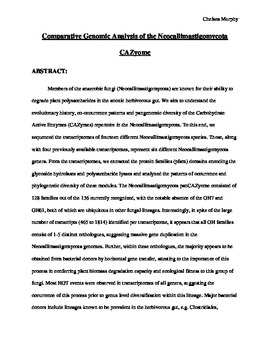| dc.description.abstract | Members of the anaerobic fungi (Neocallimastigomycota) are known for their ability to degrade plant polysaccharides in the anoxic herbivorous gut. We aim to understand the evolutionary history, co-occurrence patterns and pangenomic diversity of the Carbohydrate Active Enzymes (CAZymes) repertoire in the Neocallimastigomycota. To this end, we sequenced the transcriptomes of fourteen different Neocallimastigomycota species. Those, along with four previously available transcriptomes, represent six different Neocallimastigomycota genera. From the transcriptomes, we extracted the protein families (pfam) domains encoding the glycoside hydrolases and polysaccharide lyases and analyzed the patterns of occurrence and phylogenetic diversity of these modules. The Neocallimastigomycota panCAZyome consisted of 128 families out of the 136 currently recognized, with the notable absence of the GH7 and GH61, both of which are ubiquitous in other fungal lineages. Interestingly, in spite of the large number of transcripts (465 to 1814) identified per transcriptome, it appears that all GH families consist of 1-5 distinct orthologues, suggesting massive gene duplication in the Neocallimastigomycota genomes. Further, within these orthologues, the majority appears to be obtained from bacterial donors by horizontal gene transfer, attesting to the importance of this process in conferring plant biomass degradation capacity and ecological fitness to this group of fungi. Most HGT events were observed in transcriptomes of all genera, suggesting the occurrence of this process prior to genus level diversification within this lineage. Major bacterial donors include lineages known to be prevalent in the herbivorous gut, e.g. Clostridiales, Fibrobacteriales, and Ruminoccoccales, although additional events from lineages not associated with the herbivores guts were identified. Collectively, this work demonstrates the ancient origin and massive occurrence of HGT as a driving force behind the observed AGF efficient plant biomass degradation abilities. | |
